
|
OUR YELLOWSTONE ADVENTURE |

Yellowstone National Park has the largest concentration of wildlife in the lower 48 states. The wildlife that visitors want to see the most in Yellowstone are Bears, Wolves, Moose, Elk, Bison, Badgers, Otters, Fox and any newborn critter.
I
did some research on the web and discovered the following National Park
Service Statistics for the wildlife of Yellowstone:
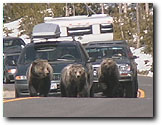
Grizzly bears are perhaps the #1 sought after (from a distance) mammal visitors would like to see. The best opportunity to see grizzlies are early morning and late evening in Hayden and Lamar Valley. Grizzly bears are identified by their large hump above the shoulders and their rump is lower than the shoulders. They are larger than the black bear and have a slightly upturned nose. We looked hard for a grizzly, but alas - no luck in seeing one (this trip.....).
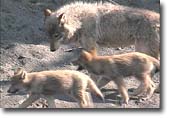 Wolves
Wolves
There are currently 13 wolf packs making Yellowstone National Park their home. The best areas to view wolves are Lamar and Hayden Valley during the early morning and late evening hours. Look for Ravens scavaging on a carcass. Wolves are some of the most intelligent mammals on the planet. Treat them with the utmost respect. No wolf has attacked a human in Yellowstone, but a few attacks have occurred in other places. Almost all were from wolves that had become conditioned to human foods. Like coyotes, wolves can quickly learn to associate campgrounds, picnic areas, and roads with easy food. This often leads to aggressive behavior toward humans. Even though the outdated distance rule of 25 yards applies to wolves, give them at least 100 yards. Once Yellowstone wolves have become habituated to humans and if fed they become a danger and must be relocated or worse. You can identify a wolf from a coyote from its size. A wolf can be 2 to 3 times larger than a coyote. A wolf has longer legs and longer gallop. Their face is rounder, the ears and nose are not as sharp. Most often than not they are with a pack whereas coyotes are often solitary.
Moose
There are over 400 Moose in Yellowstone, however their numbers have declined in the last 40 years due to drought, predation, loss of habitat and other factors. Moose are the largest member of the deer family and can be found in the marshy areas of the park including lake shores and along rivers. A bull moose in rut can be very dangerous so once again the 25 yard rule should not apply to any large mammal during the rut. Unlike elk, moose are solitary and can live up to 20 years in Yellowstone. Their favorite food is willows and aquatic vegetation.
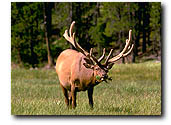 Elk
Elk
Easily the largest population of large mammals in Yelllowstone Park with over 15,000, elk in Yellowstone have a comfortable life. During the fall, the bull elk in rut, is a favorite amongst wildlife watchers and photographers. The mating season (rut) generally occurs from early September to mid-October. Elk gather in mixed herdsólots of females and calves, with a few bulls nearby. Bulls bugle to announce their availability and fitness to females and to warn and challenge other bulls. When answered, bulls move toward one another and sometimes engage in battle for access to the cows. They crash their antlers together, push each other intensely, and wrestle for dominance. While loud and extremely strenuous, fights rarely cause serious injury. The weaker bull ultimately gives up and wanders off. There is a great sequence of this in the new dvd "Wildlife of Yellowstone". Elk Calves are born in May and June and are some of the cutest newborns in the park
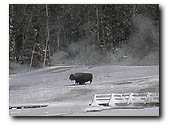
Yellowstone National Park is the only place in the lower 48 states to have a continuously free-ranging bison population since prehistoric times. Because of their sheer physical size, their numbers increase each year in Yellowstone Park. There are over 4,000 bison residing in Yellowstone and are the #1 cause of summer jams in the park. Traffic can be at a standstill for hours but still we love them. Bison mate in July and August and the mature bulls begin their head butting during this mating period. Bison can exceed over 2,000 lbs and cause more human injuries than any other wildlife combined in Yellowstone Park. Given their docile nature (except when in rut) visitors loose precaution when approaching bison and that's when they become gore victims. Bison can exceed speeds of 30 mph - how fast can the average Yellowstone tourist run. The smart money would be on the Bison. Bison calves are born in late April and May and again, due to the sheer size of their parents. rarely do the calves become victims of predation. Like elk, bison are everywhere throughout Yellowstone so there is no need to stop your vehicle in the middle of the road the take a quick digital snapshot unless the bison are in the road then please slowly give them the right of way.
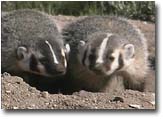 Badgers
Badgers
Even though the park service lists the badger as common, most visitors do not ever seen one when visiting Yellowstone. Badgers inhabit the sageland or Savannah areas of the park like Lamar Valley. Badgers dig for a living. They dig new dens and take over old ones prior to breeding. They find their main food source, the ground squirrel or pocket gopher, by digging. During the early and late hours of the day, when driving along the sagebrush areas of the park, you may often locate a badger by spotting a "dirt" geyser spouting out of the sagebrush. This is your clue to a badger at work. Keep your distance, as they are as ferocious as their elusive cousin the wolverine.
 Otters
Otters
The Yellowstone otter is a favorite amongt wildlife watchers that come to the park. These water mammals are very social and are always at play. They inhabit the shorelines of lakes and river courses and can be found along Yellowstone lake and river, Trout Lake and the Madison River. Their main food source is the cutthroat trout, whitefish, clams and anything else swimming in their enviironment. They use log jams and river banks as their temporary shelter and often travel miles a day in search of food and play.
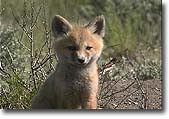 Fox
Fox
The fox is the smallest of the dog family in Yellowtone Park. They are a joy to watch but are highly elusive due to their cautious nature and smaller size compared to their much large predatory cousin the wolf and coyote. Unlike the wolf and coyote they rarely howl or sing. The best time is early morning and late evening as they hunt the rodent family that inhabit the park. The Yellowstone fox can be found primarily in the northern section of the park like Specimen Ridge and Lamar Valley. Foxes can become habituated to humans usually due to being fed. One fox in the summer of 1997 was trapped and relocated three times from the Tower Fall parking area because visitors fed it human food. The fox was relocated between 10 and 60 miles away from Tower but twice it returned. Finally the fox came to Mammoth where it was fed again and as a result was destroyed.
We saw a large number of animals - mostly bison - during our visit. I will add some images below: